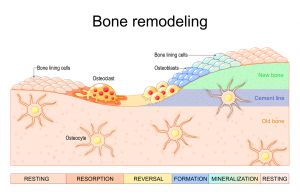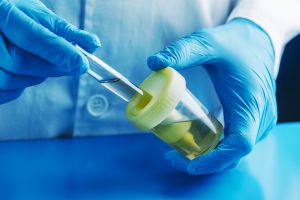
 The Toxic Effects of Lead Exposure on Bone Health
The Toxic Effects of Lead Exposure on Bone Health
Did you know bones are metabolically active organs that are restructured daily? Bone tissue is constantly broken down, so a new, stronger bone matrix can be produced. Therefore, bone health must be supported each day via a nutrient-dense healthy diet, weight-bearing exercise, supplementation for some patients, and the avoidance of toxic compounds, including lead, that can damage bone tissue.
Lead is a toxic heavy metal that is deposited and stored in bone tissue, where it can cause harm. This article reviews the harmful effects of lead on bone, sources of toxic lead, symptoms of lead toxicity, and testing for lead exposure.
Healthy Remodeling of Bone Matrix (Bone Tissue)
Bone is a living tissue that is constantly regenerated and mineralized for strength. The overall breakdown and formation of bone tissue is a process known as bone remodeling. The breakdown of bone tissue is known as bone resorption. An imbalance in bone resorption and formation can lead to decreased bone mineral density and several health concerns, including osteopenia and osteoporosis.1
 Specialized Cells for Bone Remodeling
Specialized Cells for Bone Remodeling
Osteocytes are the most abundant cells present in bone – approximately 90% to 95% of all bone cells. Osteocytes are former osteoblasts entombed within the mineralized and collagenous bone matrix.1 Osteoblasts are the specialized bone cells that regenerate bone tissue and boost bone strength. Osteoblasts produce new bone mass by synthesizing and calcifying the newly generated collagen.1
Osteoclasts are the bone cells responsible for bone resorption (bone breakdown). Osteoclasts clear out bone tissue that has not been used (use it or lose it!) and bone tissue that has been damaged so it can be replaced with healthy bone tissue.1
The Impact of the Toxic Heavy Metal Lead on Bone Health
Bone is the most common location of lead storage in the body. Approximately 90% of the total body burden of lead is stored in bone tissue.2 But – lead is an element that does not play any physiological or beneficial role in the human body, and research shows it can be harmful to the bone tissue.
Toxic lead reduces the optimal activity of many enzymes and the function of structural proteins, which are critically important in bone. Lead is highly toxic to the specialized bone cells, including osteoclasts and osteoblasts. Lead has also been recognized as a risk factor that can contribute to the development of osteoporosis, especially in perimenopausal women.3
Lead has both direct and indirect effects on bone cells. Animal studies show that lead can directly reduce bone mineral density, increase susceptibility to fractures, and impair the union (healing) of a fractured bone. Moreover, studies show lead causes an imbalance in bone remodeling by stimulating both bone formation and resorption, which results in the formation of more fragile bones.3
Lead also influences the metabolism of vitamin D3. The kidneys activate vitamin D, and toxic lead can impair this process. When optimal vitamin D is not synthesized or activated, calcium and phosphorous, which are required for optimal bone health, cannot be adequately absorbed by the gastrointestinal (GI) tract.3 Furthermore, exposure to lead induces oxidative stress in cells by generating reactive oxygen species (ROS). Various inflammatory signaling pathways are then triggered to impact the activity of the immune system, potentially resulting in autoimmune reactions, inflammation, sensitization, and reduced resilience from diseases.4
Lead can also accumulate in and cause damage to the liver, lungs, heart, skin, muscles, and kidneys.3
What is the Most Common Source of Exposure to Toxic Lead?
Drinking water is the most common source of daily lead exposure in the general population. Many water systems still have lead pipes, even though the US EPA banned them in 1986. A study published in 2024 estimated that 68% of children under the age of 6 living in Chicago are exposed to drinking water contaminated with lead.5
Even bottled water can contain lead. The FDA set five parts per billion (ppb) as the limit for lead in bottled water. The FDA threshold for taking action to remove lead from public drinking water systems is an astounding 15 ppb. According to the American Academy of Pediatrics, no amount of lead in drinking water is safe, so the lead limit for all water should be zero ppb.5
Exclusively drinking and using filtered water for cooking could be helpful, but to be confident that a filter removes all lead from water, it must meet the NSF 53 certification standards.5 Consider recommending a filter that meets these standards to every patient.
What are Other Sources of Exposure to the Element Lead?
Occupational exposure to lead can occur in plumbers, battery manufacturers, lead smelters, automobile mechanics, recyclers, refiners, painters, fitters, solderers, pottery and crystal glass manufacturers, welders, ceramic workers, and others.4 Lead is also in many household products, including paint, paint dust, batteries, cosmetics, gasoline, food cans, lead-glazed ceramics, lead crystal, jewelry, cigarette smoke, lead-based solder used in vinyl lunch boxes, traditional folk remedies, children’s toys, and even contaminated candy.6 Also, be mindful when consuming or prescribing bone broth since bone is the most common location of lead storage!7
Research shows the amount of lead that accumulates in bone tissue can also be affected by smoking, alcohol abuse, diet, and the duration of exposure to lead.3 Higher levels of lead are present in the bones of those who smoke compared to non-smokers. There is also an association between the higher intake of seafood and higher lead accumulation in bone. Lead levels are approximately five times higher in those who live in places where consumption of seafood is frequent, such as China, Taiwan, Spain, and Japan, than in those who live in places where consumption of seafood is less common.3
The Relationship Between Calcium and Lead
An increased need for calcium or sub-optimal dietary calcium intake can result in the increased absorption of lead since calcium and lead compete for absorption.8 Children absorb more lead than adults because their bodies require extra calcium for bone development and growth. Research suggests children absorb roughly 40-50% of dietary lead, while adults only absorb 5-10% of ingested lead.6
What Are the Signs & Symptoms of Lead Toxicity?
Severe, acute symptoms of lead toxicity could develop after exposure to a high amount of lead within a short timeframe. Exposure to low doses of lead over many years could contribute to chronic symptoms.
Signs and symptoms of lead toxicity include:
- Abdominal cramps
- Abdominal pain
- Abnormal bone marrow smear test
- Abnormal liver function tests
- Anemia
- Anxiety
- Chest pain
- Depression
- Fatigue
- Headache
- Muscle paralysis
- Nausea
- Neurological symptoms, including numbness (peripheral neuropathy)
- Vomiting
- Weakness of arms and legs9
In general, toxic lead can harm every organ in the body and is classified as a probable human carcinogen by the International Agency for Research on Cancer. Bone is particularly vulnerable to the harmful effects of toxic lead since it is the primary storage site.4
The Best Test Panel to Assess Exposure to Lead & Other Toxic Heavy Metals
Test for current exposure to and the approximate stored levels of up to 36 toxic heavy metals and elements with the Toxic Metals and Elements (TME) Test Panels.
DiagnosTechs offers six different TME Test Panels:
- Salivary Metals and Elements (SMETALS)
- Urinary Metals and Elements (UMETALS)
- Salivary and Urinary Metals and Elements Combo Panel (CMETALS)
- Timed Salivary Metals and Elements (TSMETALS)
- Timed Urinary Metals and Elements (TUMETALS)
- Timed Salivary and Urinary Metals and Elements Combo (TCMETALS)
The regular (single collection) TME Panels primarily assess baseline current exposure levels to metals and elements rather than the stored or past exposure. The Timed TME Panels are designed for use with a chelating or provoking agent, which will mobilize the stored pool of toxic metals to assess the approximate body burden compared to the baseline exposure levels.
Targeted Heavy Metal Detox Protocol
Once test results reveal which toxic heavy metals are clinical concerns, an efficient and individualized treatment protocol that includes reducing exposure to and supporting the detoxification of specific toxic metals, including lead, can be prescribed to support the optimal health of your patients.
To place a test order, click here. As a reminder, DiagnosTechs will drop ship test kits directly to your patients. You may select this option at the top of the order form.
Please visit our Provider Tools page for more information about choosing the right test, TME – FAQs for Providers, provocation protocols, test result interpretation, and treatment options.
 References:
References:
- Hart NH, Newton RU, Tan J, et al. Biological basis of bone strength: anatomy, physiology and measurement. J Musculoskelet Neuronal Interact. 2020;20(3):347-371.
- Li X, Li R, Yan J, et al. Co-exposure of cadmium and lead on bone health in a southwestern Chinese population aged 40-75 years. J Appl Toxicol. 2020;40(3):352-362. doi:10.1002/jat.3908
- Ciosek Ż, Kot K, Kosik-Bogacka D, et al. The Effects of Calcium, Magnesium, Phosphorus, Fluoride, and Lead on Bone Tissue. Biomolecules. 2021;11(4):506. doi:10.3390/biom11040506
- Harshitha P, Bose K, Dsouza HS. Influence of lead-induced toxicity on the inflammatory cytokines. Toxicology. 2024;503:153771. doi:10.1016/j.tox.2024.153771
- Thomas A. Lead’s lingering threat: Water and more pose dangers. Medscape. April 5, 2024. Accessed May 21, 2024. https://www.medscape.com/viewarticle/lead-has-not-gone-away-what-should-pediatric-clinicians-do-2024a10006hx.
- Ramírez Ortega D, González Esquivel DF, Blanco Ayala T, et al. Cognitive Impairment Induced by Lead Exposure during Lifespan: Mechanisms of Lead Neurotoxicity. Toxics. 2021;9(2):23. doi:10.3390/toxics9020023
- Monro JA, Leon R, Puri BK. The risk of lead contamination in bone broth diets. Med Hypotheses. 2013;80(4):389-390. doi:10.1016/j.mehy.2012.12.026
- Blake KC, Mann M. Effect of calcium and phosphorus on the gastrointestinal absorption of 203Pb in man. Environ Res. 1983;30(1):188-194. doi:10.1016/0013-9351(83)90179-2
- Zhang L, Yao X, Chen Y, et al. Abdominal pain caused by Tibetan medicine: A case report of lead poisoning. Heliyon. 2024;10(10):e30167. doi:10.1016/j.heliyon.2024.e30167









